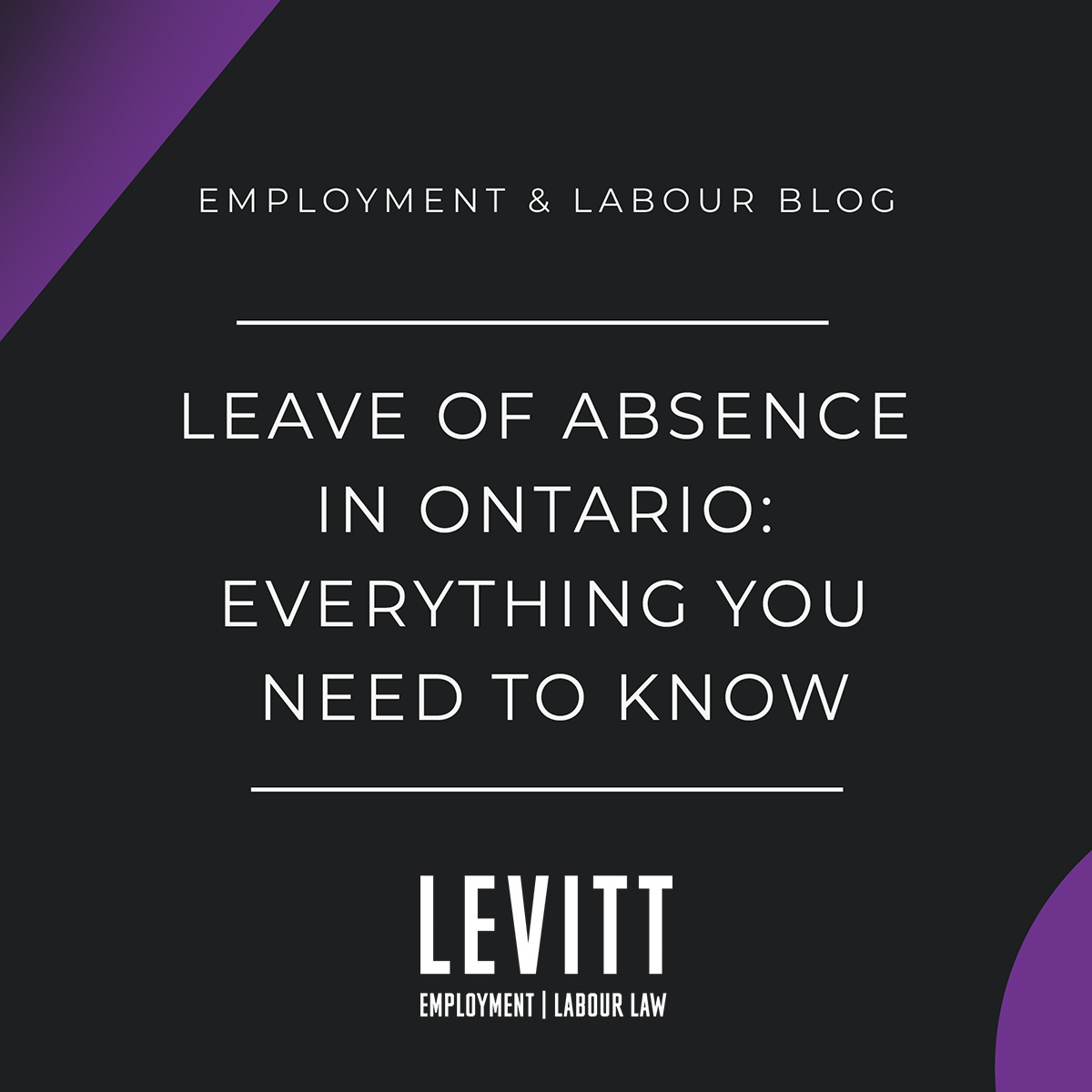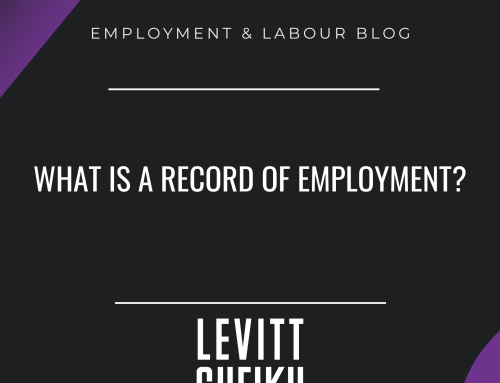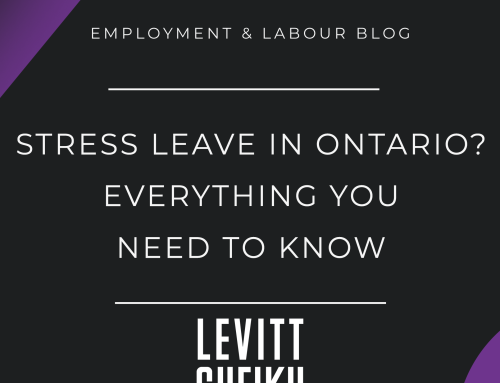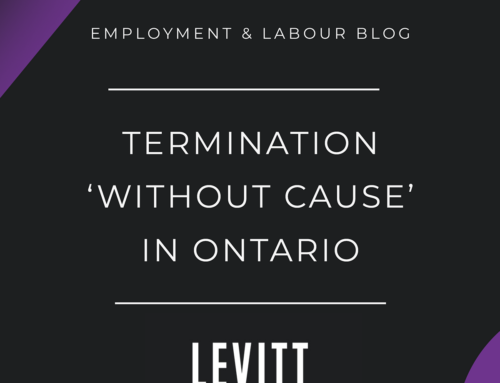What is a leave of absence?
Stress leave is a type of leave of absence. A leave of absence is time away from one’s job to deal with some unusual or unexpected circumstance. Often these circumstances are of an urgent manner, but not always. There are many types of leaves of absence including pregnancy leave, parental leave, organ donor leave, and critical illness leave.
What is Stress Leave?
Stress leave is available to an employee under a “Sick Leave”. Sick leave, under Ontario’s Employment Standards Act (ESA), sets out the minimum requirements for sick leave, and answers questions such as:
- Are you entitled to sick leave?
- How many days am I allowed?
- What do my reasons have to be?
- Do I need to be give notice?
- Do I need a medical note?
It is important to note that an individual’s employment contract can answer these questions, as well as set out more entitlements than the ESA provides. For example, your contract may give you more days for sick leave or a procedure for giving notice prior to sick leave.
If your employment contract or collective agreement provides a greater right or benefit, then the terms of your contract will apply instead of the ESA. For example, if your contract allows for 5 days sick leave, you will be entitled to those 5 days and not the minimum 3 days stated in the ESA. The employment contract may also give separate days for “stress leave”, but if not, stress leave can be included under sick leave, family responsibility leave, and leave for bereavement.
To better understand what benefits your employment contract has or what you are entitled to, you should consult us.
Am I Entitled to Sick Leave?
An employee who has been employed for at least two consecutive weeks is entitled to a leave of absence without pay because of a personal illness, injury or medical emergency.
How many days am I allowed?
The entitlement for sick leave is capped at a total of three days in each calendar year. If an employee takes a portion or part of one day for sick leave, the employer can deem it to be a full day taken under the leave.
If your employment contract allows for one paid sick day, it will amount to one unpaid sick leave under the ESA. That would leave the employee with two additional unpaid sick leave days in the year, but not additional paid sick days under his or her contract.
An employee is not able to carry over unused sick days to the next calendar year.
Do I still get benefits while on sick leave?
In Ontario, employees continue to participate in benefit plans while on sick leave. Employees may elect in writing not to do so. the employer must continue making contributions to the benefit plan unless the employee has elected not to continue participating in the benefit plan.
What do my reasons have to be?
An employee can take a sick leave for an illness, injury or medical emergency for himself or herself. It does not matter what caused the illness or injury (e.g. it can even be from your own recklessness). If the employer does not allow you to exercise your entitlement to take a sick leave, you should contact us.
Do I need to give notice?
If an employee wishes to take a sick leave, that employee should advise their employer that they will be doing do. If the employee must leave before being able to advise their employer, the employee should advise its employer as soon as possible before beginning the leave. Notice is not required in writing and therefore oral notice for the leave is sufficient. If the employer has a policy on notice, and the employee is unable to give the required notice stipulated in that policy, the employee will not lose the right to take their entitled leave.
Do I need a medical note?
An employer may ask an employee who decides to take a sick leave to provide evidence “reasonable” in the circumstances.
What may be reasonable will depend upon the facts of your specific situation, such as:
- How long you will be away;
- How many other absences you have; and
- What is common in the workplace.
Therefore, it may be reasonable in your circumstances to provide a medical note.
If an employer does require a medical note from a health practitioner, the employer may only ask for the following information:
- The duration of the absence;
- Date the employee was seen by a health care professional;
- Whether the patient was examined in person by the health care professional who wrote the note.
This means an employer cannot ask an employee information about the diagnosis or treatment of an employee’s medical condition.
The purpose of the note is for the doctor to certify the employee cannot work because of a medical condition. If the medical condition is a disability, the employee is protected under the Ontario Human Rights Code and must be accommodated for by the employer. This is known as the “duty to accommodate”. Briefly, the duty to accommodate means that an employer has a duty to remove barriers which prevent employees from doing their job. Check out our article on the Duty to Accommodate (link to Duty to Accommodate, forthcoming) for more information.
How do I get Stress Leave in Ontario?
The first step in getting stress leave is to read what your employment contract stipulates. For example, are there specific days for stress leave? If not, how many days are you entitled to under sick leave?
If there are no specific provisions about sick leave, you are automatically entitled to three days under the ESA if you have worked for that employer for two consecutive weeks.
If you are unsure about what your employment contract says or are confused by its’ terms, you should speak to your supervisor or dedicated human resources manager, or call us.
What are the Grounds for Stress Leave?
As stress leave is not a separate leave under the ESA, the grounds for stress leave would be the grounds for sick leave. The grounds for a sick leave would be an illness, injury, or medical emergency for yourself.
Stress leave might also be availed under family responsibility leave or leave for bereavement. Both leaves are explained below.
Is there a Mental Health Leave in Ontario?
A leave associated with mental health would fall under the category of “sick leave” in Ontario.
Other Leaves Related to Stress Leave
Others leaves that can be taken associated with stress are a family responsibility leave and a leave for bereavement. Both are unpaid, although an individual employment contract may give paid leaves for these categories.
Family Responsibility Leave
An employee who has been employed for at least two consecutive weeks is entitled to a leave of absence, without pay, for an illness, injury or medical emergency for the following individuals:
- Your spouse
- A parent, stepparent or foster parent for yourself or your spouse
- A child, stepchild or foster child for yourself or your spouse
- Your child’s spouse
- A grandparent, step-grandparent, grandchild or step grandchild for yourself or your spouse
- Your brother or sister
- A relative who is dependent on your care of assistance
Leave for Bereavement
An employee who has been employed for at least two consecutive weeks is entitled to a leave of absence, without pay, because of the death of any of the following individuals:
- Your spouse
- A parent, stepparent or foster parent for yourself or your spouse
- A child, stepchild or foster child for yourself or your spouse
- Your child’s spouse
- A grandparent, step-grandparent, grandchild or step grandchild for yourself or your spouse
- Your brother or sister
- A relative who is dependent on your care of assistance
The End of Leave
As with any type of leave of absence, once stress leave ends, the employer must reinstate the employee to the position the employee most recently held. If that position no longer exists, the employer must reinstate the employee in a comparable position. When the employee is reinstated, the employer has to pay the same rate the employee most recently earned, or the rate the employee would be earning had they worked throughout the leave – whichever is higher.






